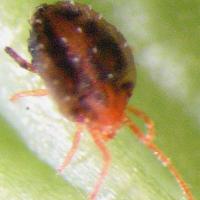Diagnosing bryobia mite
Bryobia mite, also known as clover mite, is a sap-sucking pest of broadleaf crops and pastures, that can seriously damage canola especially where there has been a 'green bridge' consisting of clover and a warm start to the growing season.
What to look for
- Adult mites are slightly smaller than a pinhead with a reddish-grey, pie-shaped body, with red legs and two long forelegs.
Insect Adult
- Long trails composed of whitish grey spots on the top of cotyledons and the leaf surface.
- Damage is more severe when seedlings are stressed (for example, autumn winter drought).
Plant
What else could it be
| Condition | Similarities | Differences |
|---|---|---|
| Diagnosing redlegged earth mite | Bleaching of leaf tissue. Larval stage same colour red legs | Redlegged earth mite (RLEM) aggregate to feed and cause extensive bleaching not whitish trails on leaf surface RLEM has black body with red legs; only found if cold temperature requirements for hatching have been met Bryobia mite has extended front legs that are 1.5 times the size of its other legs |
| Diagnosing blue oat mite | Bleaching of leaf tissue. Larval stage same colour red legs | Blue oat mite (BOM) like RLEM cause extensive bleaching rather than whitish trails on leaf surface BOM has a black body with red legs and red dot on back; only present if cold temperature requirements for hatching have been met Bryobia mite has extended front legs that are 1.5 times the size of its other legs |
| Diagnosing balaustium mite | Causes bleaching of leaf tissue. Larval stage same colour. Red legs. Present at same time of year as bryobia mite | Bryobia mite leaves white trails on the leaf surface and has extended front legs Adult balaustium mite is 2mm in length, over twice the size of an adult Bryobia mite Bryobia mite has extended front legs that are 1.5 times the size of its other legs |
Where did it come from?
- Over-wintering eggs are most likely laid early to mid winter and hatch as conditions warm up in spring. As pastures deteriorate in late spring or summer, over-summering eggs are laid.
- These eggs hatch as soon as there is sufficient moisture for plants to germinate.
- Adult clover mites are most active in warm conditions especially in late spring summer and autumn. These mites do not generally survive cold winter conditions or very dry summer conditions. All life stages can be present in protected areas if there is sufficient green plant material.
Management strategies

Spraying insecticide

Grass weed control
- Bryobia mite is difficult to control if sprays are targeted to stop damage to crops at emergence.
- It is best controlled by killing all weeds well before seeding and/or applying a miticide to the weeds with the knockdown herbicide.
Economic and financial considerations
To assist in assessing the economic risk and financial costs associated with various treatment strategies go to MyEconomicTool
There may be other economic and financial implications that need to be considered when choosing a management option. These may include:
Pre-crop- Understand the potential yield losses associated with mite feeding damage.
- Assess the costs and benefits of taking preventative action.
- Assess the cost and benefits of controlling summer weeds to reduce potential feed source.
- Compare the costs, benefits and risk of each management option against doing nothing.
- Consider risk and associated costs or savings of no treatment or delaying treatment.
- Ignore all previous treatment costs in assessing current management options.
- Undertake a “what if” scenario analysis to see what impact changing assumptions (e.g. grain price and seasonal conditions), have on the projected economic outcomes.
- Include a resistance management strategy into your spray program to reduce the chance of mites and other non-target pests developing resistance.
View these economic considerations in more detail.
How can it be monitored?
- Monitor canola crops from seeding, especially crops sown in warm weather and in paddocks where there has been a green bridge or susceptible crop or pasture the previous year.
Further information
Page last updated: Wednesday, 20 May 2015 - 11:39am



